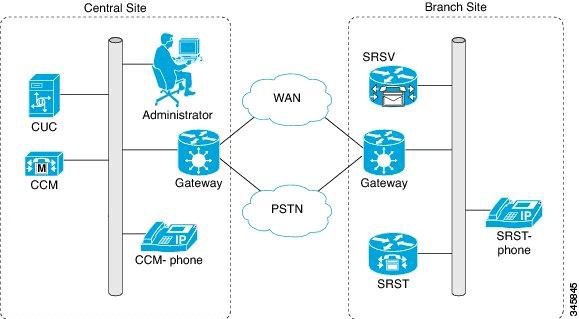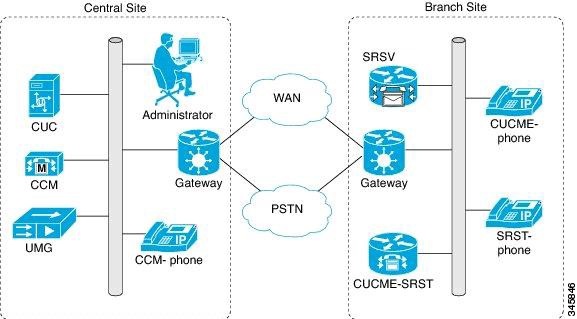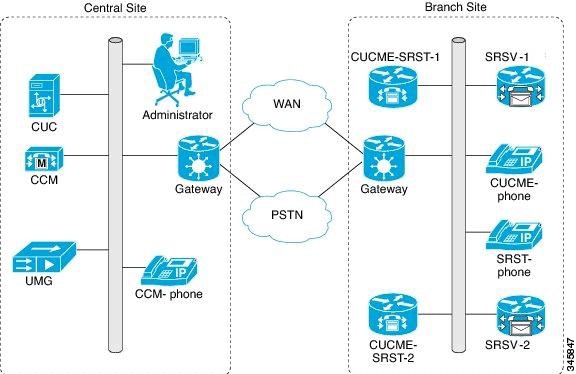- Cisco Community
- Technology and Support
- Collaboration
- Unified Communications Infrastructure
- Re: Survivable Remote Site Voicemail (SRSV) 8.6 Beta now open!
- Subscribe to RSS Feed
- Mark Topic as New
- Mark Topic as Read
- Float this Topic for Current User
- Bookmark
- Subscribe
- Mute
- Printer Friendly Page
Survivable Remote Site Voicemail (SRSV) 8.6 Beta now open!
- Mark as New
- Bookmark
- Subscribe
- Mute
- Subscribe to RSS Feed
- Permalink
- Report Inappropriate Content
03-25-2011 11:13 AM
Hello everyone,
• Automated UMG Clustering and failover support - Automated seamless UMG clustering
• Centralized software upgrades - Touch free voice mail nodes are now automatically upgraded to the latest software version.
• Call handler support enhancements - One step closer to true resemblance with Unity Connection call handlers.
• Notification device support - Notification devices and schedules are synchronized as well ... automatically!
If you need more information about the product visit www.cisco.com/go/srsv. Contact me if you are interested in participating in the beta - karmakar@cisco.com
Thanks,
Abhi.
- Labels:
-
Unified Communications
- Mark as New
- Bookmark
- Subscribe
- Mute
- Subscribe to RSS Feed
- Permalink
- Report Inappropriate Content
09-22-2012 11:28 AM
Hi
Need to provision Voicemail Redundancy for 350 VM users using Cisco Unified Messaging gateway and CUE8.6 at Remote Site
HQ Site: Cisco Unity Connection8.6
At Branch Site: on Voice Gateway 3925 ISR, SM-SRE-700-k9 used for CUE8.6
Cisco 3925 comes with two Service Module slots. In this case, one SM slot is used by CUE8.6 and the second SM Slot need to be
factored for Cisco UMG (Unified Messaging Gateway).
When we take the spare part code: SM-SRE-700-k9=, under this select Unifed Messaging 8.6 option(SUMG-SM7-86-k9), it later ask to
select Feature license UMG Lic for 25E-SRST nodes/sites quantity. Waht is this required for since we are looking for SRSV and not E-SRST
What should be the correct part code for unified messaging gateway using SM-SRE-700-K9
Also, noticed that SRSV capability of UMG has been annoucned EOS/EOL and the last day to order the product was
June 18, 2012:
In such a case how to go about provisioning VoiceMail Redundancy using UMG?
If SRSV has been declared EOL/EOS and if Voicemail redundancy is required using UMG8.6, then what is the replacement for SRSV or is it that SRSV functionality has been incorporated into E-SRST license?
Thanks & Regards
Sumit
- Mark as New
- Bookmark
- Subscribe
- Mute
- Subscribe to RSS Feed
- Permalink
- Report Inappropriate Content
09-22-2012 02:02 PM
Sumit
SRSV architecture is changing next year. The BU is moving away from UMG which is why you don’t see that license orderable anymore. It will use Uconn natively to communicate with SRE module. Initial guidance is that it will only work with SRE 910 since the SRE will not be running CUE code but rather full blown Uconn code and the lower performance models don’t have the horsepower to run Uconn code.
Pricing/licensing for this new architecture is slated to be announced next year.
SRSV is completely different from E-SRST that still needs the UMG module
Thanks
Srini
- Mark as New
- Bookmark
- Subscribe
- Mute
- Subscribe to RSS Feed
- Permalink
- Report Inappropriate Content
09-22-2012 03:22 PM
Hi Srini,
Thanks for the prompt reply.
Kindly confirm if the following understanding is correct.
1. Currently, Cisco UMG8.6 would only support E-SRST functionality and not voicemail redundancy since SRSV has been declared EOS/EOL.
2. Inorder to ensure Voicemail Redundancy, will have to run Unity Connection (Active/Active) on two separate/diff UCS C210-M2 servers until SRSV architecture is changed next year.
3. As per the new SRSV architecture which is probably going to be released next year, instead of UMG Unity connection will be used to communicate with SRE module (SM-SRE-910-K9) and this SRE module will host full blown Unity Connection inplace of CUE
Thanks & Regards
Sumit
- Mark as New
- Bookmark
- Subscribe
- Mute
- Subscribe to RSS Feed
- Permalink
- Report Inappropriate Content
09-22-2012 03:25 PM
The only change I would say is for
1) If you are an existing customer you could deploy it but if you are new I would wait till the new architecture flushed out and the licensing was set in stone
Other points sound good see Uconn system requirements for BW requirements for clustering Uconn over the WAN
Thanks
Srini
- Mark as New
- Bookmark
- Subscribe
- Mute
- Subscribe to RSS Feed
- Permalink
- Report Inappropriate Content
12-17-2012 05:48 AM
Hi Srini,
I noticed the same this morning when I was trying to find ordering information for SRSV functionality and I found out that the replacement solution will be native support in Unity Connection for SRSV. However, I am struggling to understand what components will be required for the overall solution.
My understanding is that UMG will not be required anymore on the central site as the capabilities for SRSV head end will be built into Unity Connection. Ofcourse there will be some license requirements on Unity Connection. Apart from that all we need is CUE module in the branch office gateway which, looking at your post, seems to be potentially an SRE 910.
Am i reading all this correctly?
Regards,
Zeeshan
- Mark as New
- Bookmark
- Subscribe
- Mute
- Subscribe to RSS Feed
- Permalink
- Report Inappropriate Content
12-17-2012 05:56 AM
That us what the BU conveyed a while back to partners
Thanks
Srini
- Mark as New
- Bookmark
- Subscribe
- Mute
- Subscribe to RSS Feed
- Permalink
- Report Inappropriate Content
12-17-2012 06:11 AM
Thanks Srini. Much appreciated!
Regards,
Zeeshan
- Mark as New
- Bookmark
- Subscribe
- Mute
- Subscribe to RSS Feed
- Permalink
- Report Inappropriate Content
01-18-2013 09:59 AM
Hi All,
Here is an excerpt from the Design Guide for SRSV.
Overview of Cisco Unity Connection SRSV in Connection 9.1(1) and Later
Revised January 16, 2013
Cisco Unity Connection Survivable Remote Site Voicemail (Connection SRSV) is a backup voicemail solution that allows you to receive voice messages during WAN outages. It works in conjunction with Cisco Unified Survivable Remote Site Telephony (SRST) for providing voicemail service to a branch when the connectivity with the central Connection voicemail service is lost.
Connection SRSV is used in the centralized Cisco Unified Communications Manager and Cisco Unity Connection environment with multiple branch offices or small sites. It provides limited voicemail and auto-attendant features that remain in synchronization with the central Connection voicemail service so that when the WAN outage or failure occurs, the Connection SRSV solution can provide voicemail service to the subscribers at the branch. However, as soon as the network is restored, all the voicemails received by the branch subscribers are automatically uploaded to the central Connection voicemail server.
Connection SRSV solution requires the following two components:
•![]() Cisco Unity Connection: It is deployed at the central site alongside with Cisco Unified CM to deliver powerful integrated messaging and voicemail services.
Cisco Unity Connection: It is deployed at the central site alongside with Cisco Unified CM to deliver powerful integrated messaging and voicemail services.
•![]() Connection SRSV: The SRSV component is natively a part of Connection which is deployed at the branch site alongside with Cisco Unified CM Express or Cisco Unified Survivable Remote Site Telephony (SRST). Connection SRSV is hosted on Cisco Integrated Service Routers Generation 2 (ISR G2) platform by using Services Ready Engine Virtualization.
Connection SRSV: The SRSV component is natively a part of Connection which is deployed at the branch site alongside with Cisco Unified CM Express or Cisco Unified Survivable Remote Site Telephony (SRST). Connection SRSV is hosted on Cisco Integrated Service Routers Generation 2 (ISR G2) platform by using Services Ready Engine Virtualization.
See the following sections:
Supported SRSV Topologies
Connection SRSV supports several topologies based on the configuration of the router. You can deploy either original SRST or CUCME-as-SRST (also known as SRST Fallback Mode) at branch.

Note ![]() If you are running SRST at the branch site, you cannot also deploy the E-SRST feature.
If you are running SRST at the branch site, you cannot also deploy the E-SRST feature.
Following figures show three topolgies supported by Connection SRSV:
Figure 14-1: Shows a topology in which SRST is deployed at the branch site. If the WAN occurs or PSTN goes down, Connection SRSV at the branch site provides limited voicemail support in the failover mode.
Figure 14-2: Shows a topology where CUCME-as-SRST (also known as SRST Fallback Mode) is providing call control at the branch site.
Figure 14-3: Shows a topology where multiple CUCME-as-SRST and SRSV devices are paired for load balancing at the survivable branch site. In this scenario, the administrator uses Cisco Unified Communications Manager to divide the branch users between CUCME-SRST-1 and CUCME-SRST-2. The central Connection server detects that and then sends the appropriate configuration to SRSV-1 and SRSV-2 at the branch site. In the event of WAN failure, each SRSV device will handle calls directed to it from the paired CUCME-as-SRST device.
Figure 14-1 Topology 1

Figure 14-2 Topology 2

Figure 14-3 Topology 3

Scalibility
Each Connection SRSV branch will support 200 users per branch with a maximum of 10 branches per centralized Connection server.
Software Requirements
Connection SRSV requires Cisco Unity Connection minimum version 9.1 for both the Central Connection server as well as the SRSV branches.
Bandwidth requirements for synchronization to central Connection server after outage
The synchronization process does not have any bandwidth requirements as it is not a real-time process.
Supported Hardware
Any supported Connection hardware is suitable for Connection SRSV. Please see the current Supported Platforms List for the most up to date list of supported hardware.
http://www.cisco.com/en/US/docs/voice_ip_comm/connection/9x/supported_platforms/9xcucspl.html.
Limitations
•![]() No MWI
No MWI
•![]() No interaction between existing UMG based SRSV and Unity Connection based SRSV
No interaction between existing UMG based SRSV and Unity Connection based SRSV
•![]() No migration from UMG based SRSV
No migration from UMG based SRSV
- Mark as New
- Bookmark
- Subscribe
- Mute
- Subscribe to RSS Feed
- Permalink
- Report Inappropriate Content
09-22-2012 03:33 PM
Thank You Srini :-)
Thanks & Regards
Sumit
Discover and save your favorite ideas. Come back to expert answers, step-by-step guides, recent topics, and more.
New here? Get started with these tips. How to use Community New member guide
